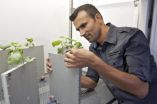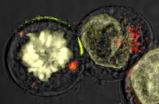(Press-News.org) It has long been known that roots alter the soil in their immediate vicinity, where other microorganisms live and the chemical composition is altered compared to that further away from the roots. An international research team has now demonstrated in experiments at the Paul Scherrer Institute that the soil in the vicinity of roots also contains more water – contrary to the earlier belief that there must be less water in this region, as the plant takes up water from the soil. Apparently, however, plants create a small water reserve that helps to tide them over through short periods of drought. These findings could help, in the long term, in the breeding of plants to cope better during periods of drought or in support of the development of efficient irrigation systems. These results were obtained from experiments carried out with the benefit of neutron tomography at the Paul Scherrer Institute, using a method that makes it possible to exactly show the distribution of water to a fraction of a millimetre, without having to remove a plant from the soil. The researchers have published their results in the prestigious journal New Phytologist.
"The question of how plants take up water is not only relevant to the development of new, water-efficient strains of plants, but also for improving climate models," explains Sascha Oswald, from the Institute of Earth and Environmental Science at the University of Potsdam, "because typically more than half of all the water that falls onto the earth's surface as rain in a humid climate is taken up by plants and then passes back to the atmosphere through the plants." A research project at the Helmholtz-Centre for Environmental Research – UFZ where he worked with a number of colleagues had the goal of showing what exactly happens at the place where a plant takes up water through its roots. "Plants take water up from the ground by means of fine roots, a few millimetres in diameter. Their thicker roots serve more as pipelines, to relay the water. We want to understand the water distribution around these roots," explains Ahmad Moradi, from the University of California Davis.
Neutrons reveal water content without damaging plants
"The decisive processes occur here at a scale of a few millimetres. In order not to miss these processes, we need a procedure that shows details that are smaller than a millimetre and that can be applied without needing to remove the plant from the soil," says Moradi of the technical challenge. The researchers found the appropriate method at the Paul Scherrer Institute in the form of neutron tomography. Here, they were able to send neutrons through plants, together with the soil around their roots. Using these particles, it is possible to see inside different objects, in a similar manner to using X-rays but making different internal components visible. Specifically, neutrons are particularly attenuated and scattered away by water, whereas metal or sand are essentially invisible to them. "Roots consist to almost 90% of water. When one wants to examine them, or the movement of water in the soil, then neutrons are far better tools than X-rays," explains Moradi.
The researchers were thus able to create an exact three-dimensional image of the water distribution around the roots and determine how much water was present at different positions in the soil. "The microscope option of the facility was used for this measurement, so that images with a resolution of 20 pixels per millimetre could be generated. In this way, it was possible to make the water visible to the required accuracy," explains Eberhard Lehmann, whose group operates the facilities at PSI. "We have three measurement stations at which we can create images with neutrons – each with its own characteristics. Thus we were able to try out different options for the experiment. A great advantage of the PSI facility is also that it is in operation 24 hours a day, and thus plants could be observed over a complete day-night cycle." PSI is the only centre in Switzerland at which neutrons are available for research.
More water at the roots
The result obtained from this study is that the soil in a region within a few millimetres from roots contains about 30% more water than the rest of the soil. It has long been known that roots significantly alter their immediate environment. In this so-called rhizosphere a much higher number of different microorganisms than elsewhere can be found. They profit from organic root excudates. "Because of the water uptake by roots it has been assumed as a matter of course that the water content close to the roots is decreased and that water is flowing along a gradient towards the roots" explains Hans-Jörg Vogel from the Department of Soil Physics at UFZ. . The experiments contradicted this belief, for all three types of plants tested – maize, lupines and chick peas.
Water reserve for bad times
"We can now only speculate about the question as to how the water concentration around the roots becomes higher. It is probable that a gel-like substance that the roots exude is responsible. This substance can absorb 10,000 times its own dry weight of water. In this way, plants could create an emergency supply for short periods of drought," explains the soil physicist Andrea Carminati, from the University of Göttingen. Even if this emergency supply does not suffice for longer periods of drought, it can help cover periods of up to 12 hours in which the plant would otherwise be cut off from a supply of water. "If one thinks about the practical applications of these results, then they can help in the breeding of plants which can survive dry periods better. One could also learn exactly how much to water plants, so that they do not come to long-lasting harm through drying out," adds Sascha Oswald.
INFORMATION:
The project
This research project was carried out by scientists from the Helmholtz Centre for Environmental Research – UFZ, the University of California Davis, the University of Potsdam and the University of Göttingen, who had all previously worked together at the UFZ. The experiments described here were performed at the Paul Scherrer Institute, PSI (Villigen, Switzerland) and supervised by PSI scientists.
The publication
Moradi, A.B., Carminati, A., Vetterlein, D., Vontobel, P., Lehmann, E., Weller, U., Vogel, H.-J., Oswald, S.E. (2011): Three-dimensional visualization and quantification of water content in rhizosphere. New Phytol.
http://dx.doi.org/10.1111/j.1469-8137.2011.03826.x
Links:
http://www.ufz.de/index.php?en=22115
http://www.psi.ch/media/plants-create-a-water-reserve-in-the-soil
Contact:
Dr. Ahmad Moradi, Department of Land, Air and Water Resources,
University of California Davis, Davis, CA 95616, USA
E-Mail: amoradi@ucdavis.edu; Tel: +1 530 752 1210
Dr. Eberhard Lehmann, Group Leader of Neutron Imaging,
Paul Scherrer Institute, 5232 Villigen PSI, Switzerland
E-Mail: eberhard.lehmann@psi.ch; Tel: +41 56 310 29 63
Prof. Dr. Sascha Oswald, Institute for Earth and Environmental Science,
University of Potsdam, 14476 Potsdam-Golm, Germany
E-Mail: sascha.oswald@uni-potsdam.de, Tel: +49 331 977 2675
Dr. Andrea Carminati, Department of Crop Sciences,
Georg-August University of Göttingen, 37018 Göttingen, Germany
E-Mail: acarmin@uni-goettingen.de, Tel: +49 551 39 4629
Prof. Dr. Hans-Jörg Vogel, Helmholtz-Centre forEnvironmental Research – UFZ, Department Soil Physics. 06120 Halle, Germany.
Tel: +49 345 558 5403
http://www.ufz.de/index.php?de=6171
Plants create a water reserve in the soil
Experiments performed at the Paul Scherrer Institute reveal that a zone of higher water concentration exists around the roots of a plant
2011-09-16
ELSE PRESS RELEASES FROM THIS DATE:
Stents may reduce heart attacks by delivering downstream medication
2011-09-16
Tuesday, September 13, 2011, Cleveland: Researchers at Cleveland Clinic have discovered that cardiac patients receiving medicated stents – a procedure that occurs often when blood vessels are blocked – have a lower likelihood of suffering heart attacks or developing new blockages in the vessel downstream from the stent.
Stents have been used to prevent re-narrowing of coronary arteries after balloon angioplasty and newer designs have included coatings with medications to prevent re-narrowing from occurring within the stent after implantation. The recent study – led by ...
Highlights of the 24th Congress of the European College of Neuropsychopharmacology (ECNP) 2011
2011-09-16
September 2011, Paris, France
The 24th ECNP Congress, which was held from 3 to 7 September 2011 in Paris, France, was once again a great success, bringing together more than 6,700 psychiatrists, neurologists, psychologists and neuroscience researchers from all over the world. ECNP is especially pleased to see an increasing number of delegates coming from outside Europe.
The annual ECNP Congress is the largest scientific meeting on mental and neurological health in Europe, promoting fruitful dialogue between neuroscientists and medical professionals. With more than ...
Cancer-killing cells are caught on film in more 3-D detail than ever before
2011-09-16
Scientists reveal in more detail than ever before how white blood cells kill diseased tissue using deadly granules, in research published today in PLoS Biology.
The researchers, from Imperial College London and the University of Oxford, used 'optical' laser tweezers and a super-resolution microscope to see the inner workings of white blood cells at the highest resolution ever. The researchers describe how a white blood cell rearranges its scaffolding of actin proteins on the inside of its membrane, to create a hole through which it delivers deadly enzyme-filled granules ...
Childhood and the driving force of fashion
2011-09-16
Are children as young as five years old so driven by consumerism and fashion that they are in danger of 'losing' their childhood?
Not necessarily, according to Dr Jane Pilcher, a sociologist at the University of Leicester, whose research findings on children and fashion were recently reported in the international journal, Childhood.
Nonetheless, her findings showed that brands and logos are highly important to some children, influenced by family attitudes, peer pressure and celebrity culture.
The desire for certain brands and logos, especially in boys' sportswear, ...
TechniTrader's Martha Stokes C.M.T. Will be Speaking at the AAII Puget Sound Chapter Event!
2011-09-16
Martha Stokes C.M.T. will be speaking at the AAII Puget Sound Chapter in Mercer Island, WA!
Saturday, September 24, 2011 from 9:00 AM - 12:00 PM.
Registration/Social at 8:30 AM.
The topic will be New Technology Cycle Investing Opportunities.
Attend this meeting and learn:
- Which sectors and industries could experience exponential growth
- Methods for separating the most competitive companies from those that are losing momentum
- The reasons why certain new industries are growing exponentially
For more information please visit:
http://sites.google.com/site/pugetsoundchapter/home
http://technitrader.com/get-connected/
Contact ...
Rice reinforces gas hydrate strategy
2011-09-16
Their critics weren't convinced the first time, but Rice University researchers didn't give up on the "ice that burns."
A paper by a Rice team expands upon previous research to locate and quantify the amount of methane hydrates -- a potentially vast source of energy -- that may be trapped under the seabed by analyzing shallow core samples. The paper published this week by the Journal of Geophysical Research- Solid Earth should silence the skeptics, the researchers said.
Chemical engineers George Hirasaki and Walter Chapman and oceanographer Gerald Dickens headed the ...
Of mice and men
2011-09-16
Scientists have sequenced the genomes (genetic codes) of 17 strains of common lab mice--an achievement that lays the groundwork for the identification of genes responsible for important traits, including diseases that afflict both mice and humans.
Mice represent the premier genetic model system for studying human diseases. What's more, the 17 strains of mice included in this study are the most common strains used in lab studies of human diseases. By enabling scientists to list all DNA differences between the 17 strains, the new genome sequences will speed the identification ...
Cheaper Autumn Days and Nights Out with New DiscountVouchers.co.uk Deals
2011-09-16
Savings at one of the UK's leading theme parks and money off at cinemas can be had from leading voucher codes website DiscountVouchers.co.uk right now thanks to new deals announced this week. The discount voucher codes website, which is home to regularly-updated deals for over 800 suppliers, has introduced new deals redeemable at Chessington World of Adventures and Cineworld.
Great evenings out at the cinema are always popular with kids, and DiscountVouchers.co.uk can help mums and dads treat the kids right now thanks to new Cineworld vouchers on show on the site. Parents ...
Personalized 3-D avatars for real life
2011-09-16
An avatar is really no more than a graphical representation, generally human, which is associated with a user for identification purposes. Avatars can be either photographs or art drawings, and certain technologies enable their use in three dimensions.
Until now, 3D avatars were mainly used as fun objects for diversion and entertainment purposes of the end user. However, the Media Unit at Tecnalia has developed a "Personalised 3D avatars" technology, the aim of which is to facilitate the building of low-cost 3D avatars.
This 3D avatar is used as a responsible interface ...
Sheffield scientists shine a light on the detection of bacterial infection
2011-09-16
Researchers at the University of Sheffield have developed polymers that fluoresce in the presence of bacteria, paving the way for the rapid detection and assessment of wound infection using ultra-violet light.
When contained in a gel and applied to a wound, the level of fluorescence detected will alert clinicians to the severity of infection. The polymers are irreversibly attached to fragments of antibiotics, which bind to either gram negative or gram positive bacteria – both of which cause very serious infections – informing clinicians as to whether to use antibiotics ...
LAST 30 PRESS RELEASES:
Numbers in our sights affect how we perceive space
SIMJ announces global collaborative book project in commemoration of its 75th anniversary
Air pollution exposure and birth weight
Obstructive sleep apnea risk and mental health conditions among older adults
How talking slows eye movements behind the wheel
The Ceramic Society of Japan’s Oxoate Ceramics Research Association launches new international book project
Heart-brain connection: international study reveals the role of the vagus nerve in keeping the heart young
Researchers identify Rb1 as a predictive biomarker for a new therapeutic strategy in some breast cancers
Survey reveals ethical gaps slowing AI adoption in pediatric surgery
Stimulant ADHD medications work differently than thought
AI overestimates how smart people are, according to HSE economists
HSE researchers create genome-wide map of quadruplexes
Scientists boost cell "powerhouses" to burn more calories
Automatic label checking: The missing step in making reliable medical AI
Low daily alcohol intake linked to 50% heightened mouth cancer risk in India
American Meteorological Society announces Rick Spinrad as 2026 President-Elect
Biomass-based carbon capture spotlighted in newly released global climate webinar recording
Illuminating invisible nano pollutants: advanced bioimaging tracks the full journey of emerging nanoscale contaminants in living systems
How does age affect recovery from spinal cord injury?
Novel AI tool offers prognosis for patients with head and neck cancer
Fathers’ microplastic exposure tied to their children’s metabolic problems
Research validates laboratory model for studying high-grade serous ovarian cancer
SIR 2026 delivers transformative breakthroughs in minimally invasive medicine to improve patient care
Stem Cell Reports most downloaded papers of 2025 highlight the breadth and impact of stem cell research
Oxford-led study estimates NHS spends around 3% of its primary and secondary care budget on the health impacts of heat and cold in England
A researcher’s long quest leads to a smart composite breakthrough
Urban wild bees act as “microbial sensors” of city health.
New study finds where you live affects recovery after a hip fracture
Forecasting the impact of fully automated vehicle adoption on US road traffic injuries
Alcohol-related hospitalizations from 2016 to 2022
[Press-News.org] Plants create a water reserve in the soilExperiments performed at the Paul Scherrer Institute reveal that a zone of higher water concentration exists around the roots of a plant


